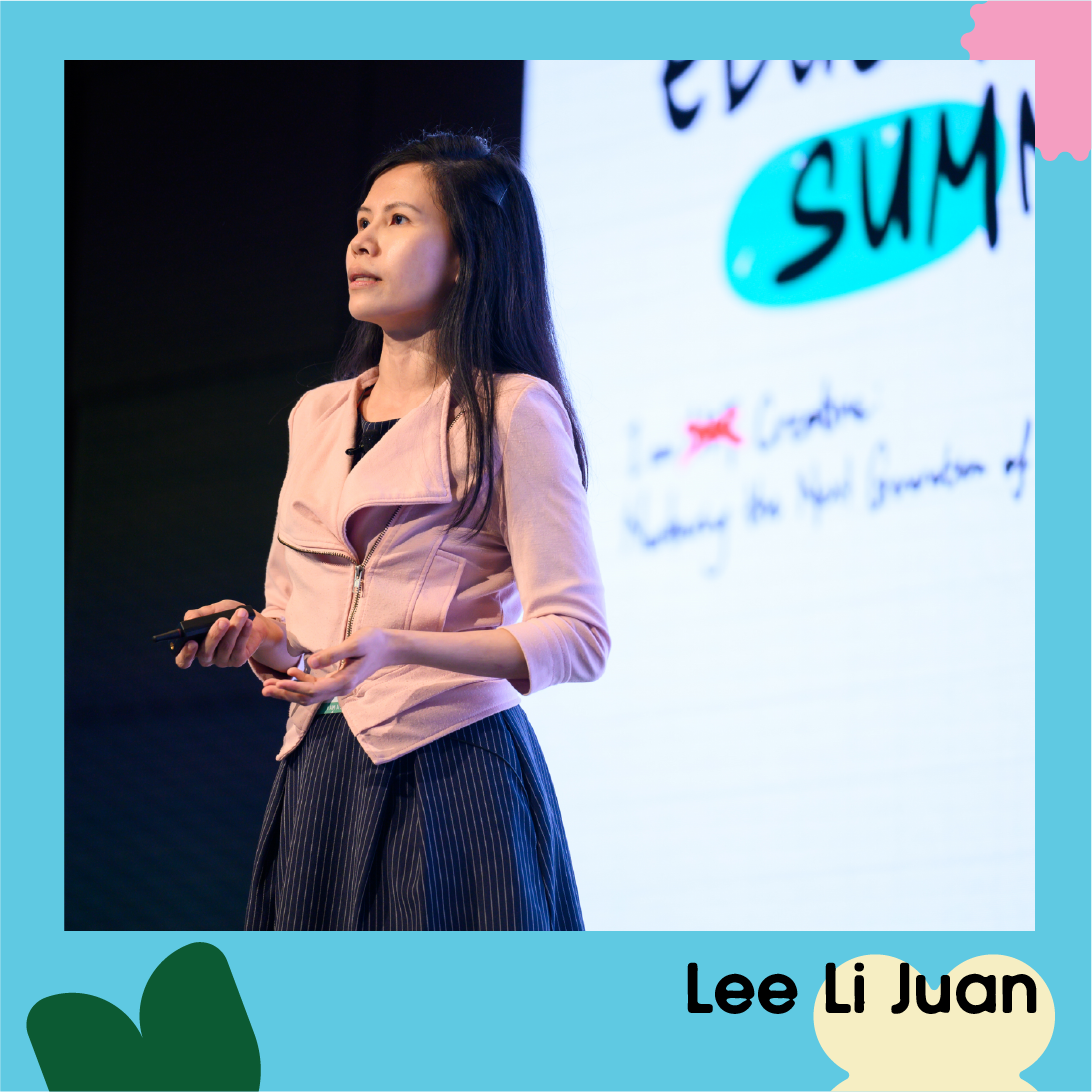Newfound creative confidence empowers changemakers
A collaborative spirit helped five secondary students from St. Joseph’s Institution create an award-winning prototype for a seniors’ social hub. The experience took their creative confidence to the next level.
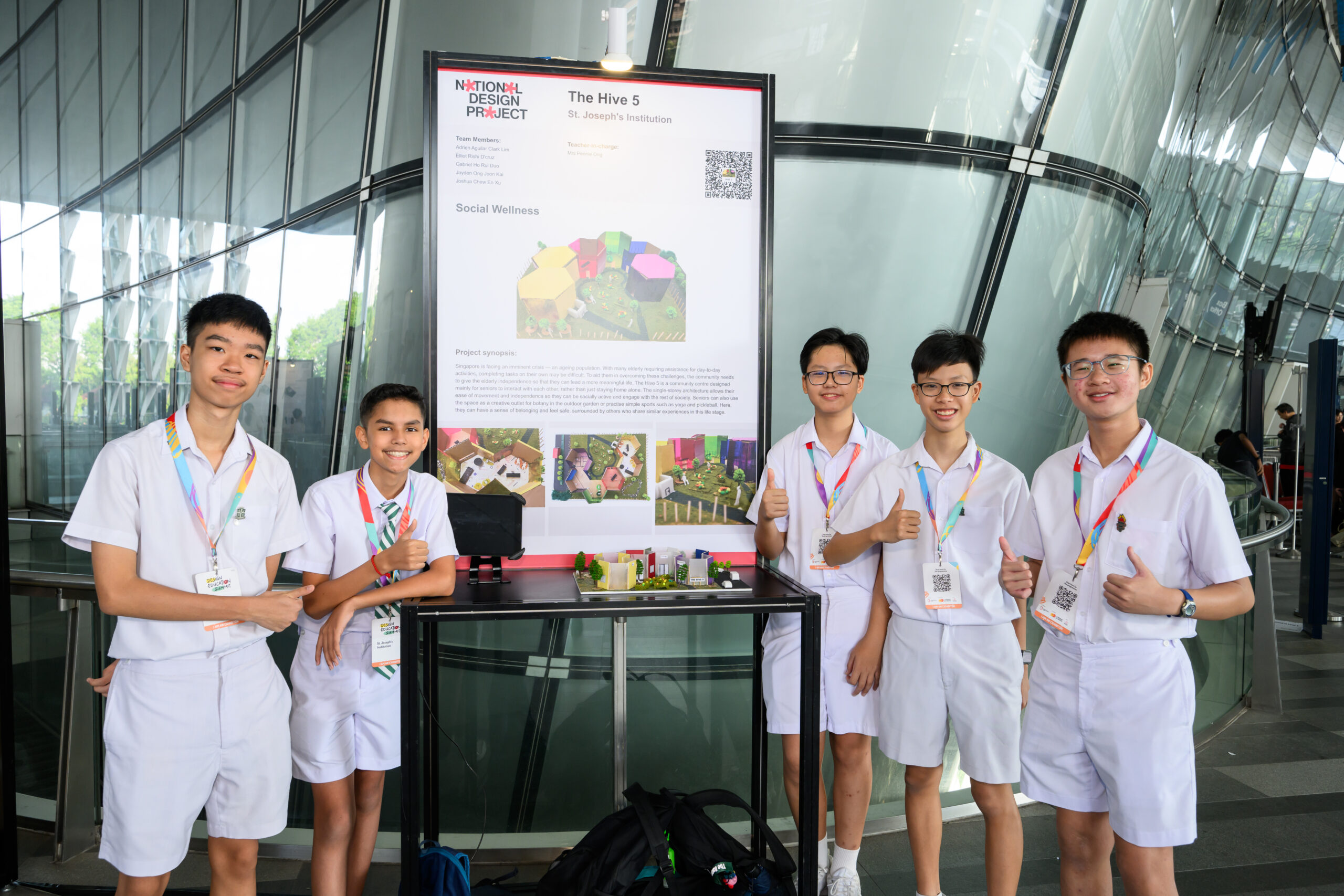
From left to right: Aguilar Adrien Clark Lim, Elliot Rishi D’Cruz, Gabriel Ho Rui Duo, Jayden Ong Joon Kai, and Joshua Chew En Xu presenting “The Hive 5” at the Design Education Summit 2023, which was held at The Star Performing Arts Centre. Photo by All The Little Things Photography.
16 Jan 2025
There’s nothing better than the satisfaction of reaching a successful conclusion to a challenging project at school. Imagine pairing that with a national-level distinction award, culminating in an opportunity to share your work with the Minister for Education, Chan Chun Sing!
That was the rewarding experience of five secondary students from St. Joseph’s Institution (SJI). They entered the first ever National Design Project in 2023 and developed a proposal for a seniors’ community centre in Toa Payoh.
SJI was one of 32 institutions that entered the National Design Project – an initiative of the Design Education Advisory Committee, which is supported by the DesignSingapore Council. The programme aims to engage youth by challenging them to find creative solutions to today’s complex issues through design thinking. The 2023 programme, themed “Design for Wellness,” was organised by Temasek Polytechnic’s School of Design.
The five trailblazing thinkers from SJI – Joshua Chew En Xu, Elliot Rishi D’Cruz, Gabriel Ho Rui Duo, Aguilar Adrien Clark Lim, and Jayden Ong Joon Kai – chose to approach the issue of wellness with a focus on loneliness among Singapore’s rapidly expanding population of over-65s.
In tackling this serious issue, the team was steered by the design thinking process and guided by advice from an industry mentor as well as educators from Temasek Polytechnic. Not only did the students create a thoughtful design; they also experienced the empowering feeling that comes with developing changemaker qualities.
“In the past, we had been really used to smooth sailing. This was different because there were twists and unexpected turns. We learned to adapt to changes, to problems."
Aguilar Adrien Clark Lim
ST. JOSEPH'S INSTITUTION
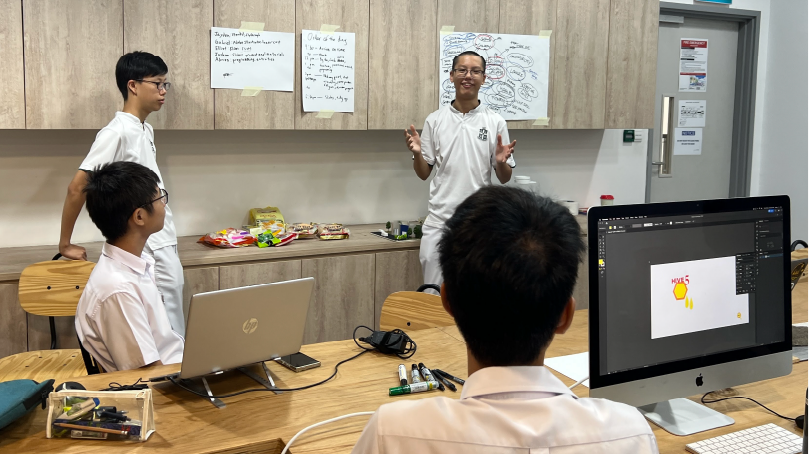
Gabriel discusses a mindmap with his teammates. Every student had their own role in the team. Gabriel was scribe and ideator. Photo by Pennie Ong.
The team arrived at the idea of designing a seniors’ social hub after considering how quickly Singapore’s population is ageing and the health risks associated with social isolation. Zeroing in on Toa Payoh, where there is a high proportion of older residents, the team embarked on the design thinking process.
They began with empathising, interviewing seniors and discovering that those being cared for by their families were happiest while those in nursing homes and hospitals experienced the most loneliness.
This was followed by defining the challenge to be addressed and creating ideas. In this stage, they came to realise that the small-scale solutions they initially discussed would not be suitable to the scale of the underlying societal issue. In the prototyping stage, they developed their concept for a beehive-inspired community centre.
Adrien admits that the process was challenging. “We did not expect we’d need such a good grasp of real-world issues before jumping into the ideation stage,” he says. But when the complexity became daunting, mentor and professional designer David Tham (Managing Director, StudioNorm Design Consultants) guided the students toward a valuable big-picture perspective. This gave them the resilience to press on.
“One of the most important things we learned from our mentor David was that because we were pitching an idea, we didn’t need to spend too much time on the specifics. Rather, we should focus on the reasoning behind doing things the way we did. This helped us find ways to solve problems as they arose.”
Aguilar Adrien Clark Lim
The prototype they created, called “The Hive 5,” is a concept for a building with a central courtyard and hexagon-shaped rooms. Seniors (and others) can meet, dine together, and engage in activities within and around six rooms: a kitchen, a double-room café, a lounge, an activity hall, and a multi-purpose court.
The various “hives” are colour coded for easy recognition and memory, and the single-storey design makes access simple while also cutting out the energy consumption that lifts would require.
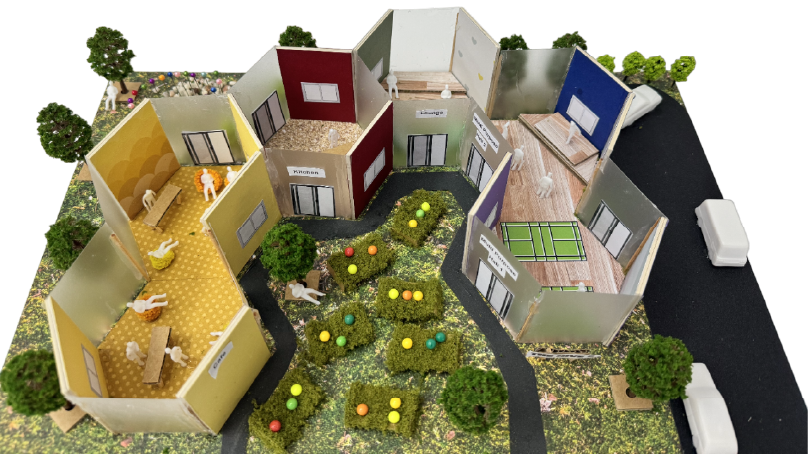
In addition to its five main zones, “The Hive 5” also features outdoor benches encircling tree trunks; a stone-stepping zone for foot reflexology; and a community garden for growing vegetables. Photo by Pennie Ong.
Everyone had a chance to bring their own talents to light. Elliot, for example, used both hand sketching and Minecraft to test out the idea of using hexagon-shaped pods with a central courtyard. Joshua’s language skills aided the interview process.
The spectrum of talents among the team members and the range of perspectives shared by the stakeholders they engaged made a big difference to the design process. The team’s understanding of key issues was enhanced, which made for a stronger solution in the end.
“As we conducted our research, we learnt that each of us had a hidden talent, which helped contribute to the success of our project. For example, Joshua was able to communicate with the seniors in Chinese fluently, which allowed us to receive feedback.”
Jayden Ong Joon Kai
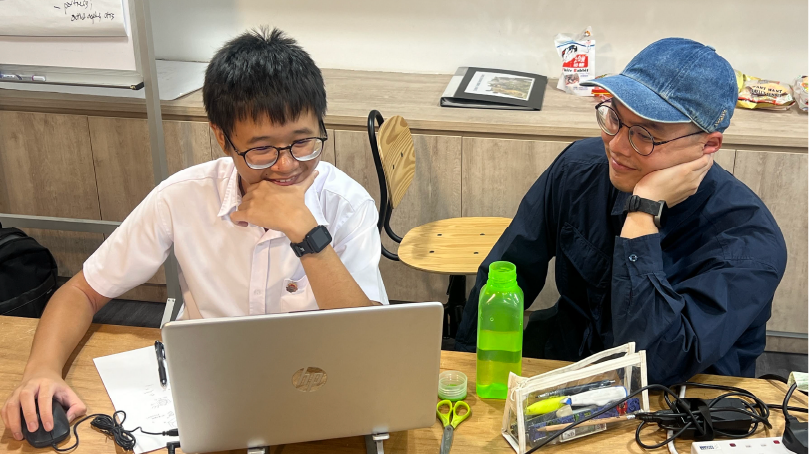
Joshua discussing the project with Temasek Polytechnic School of Design educator Bryan Angelo Lim, who mentored the team in a five-day sprint with his colleague Simon Yap. Photo by Pennie Ong.
The team had disagreements along the way, but, as Jayden explains, the collaborative design thinking process helped them develop mutual understanding. “By collaborating, we learnt how to work together and coordinate as a team,” he shares. A real benefit was that they got to know each other better.
This helped them work through challenges together and step forward with the assurance that everyone had each other’s back. Says Adrien, “Mutual trust and belief in one another is important for a team to function, and we managed to pull through because of this belief, rather than stressing ourselves out.”
“As a group, we were able to let our creative process show and really work together to ideate and design.”
Elliot Rishi D’Cruz
ST. JOSEPH'S INSTITUTION
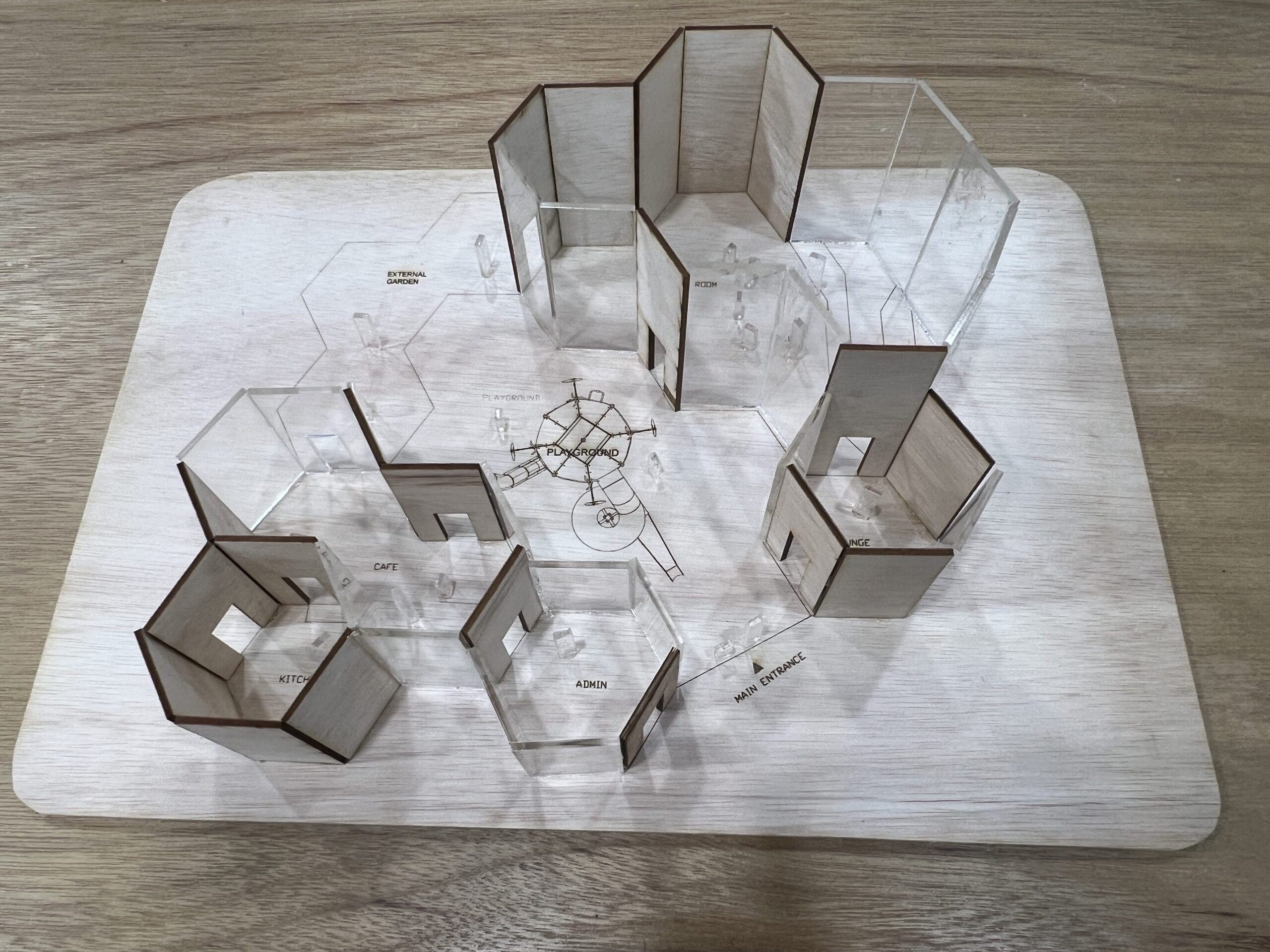
During the sprint with the Temasek Polytechnic School of Design educators, the team developed their prototype concept further and created a laser-cut model. Photo by Pennie Ong.
A wonderful additional outcome of their award in the National Design Project was the opportunity to showcase their project at the Design Education Summit 2023, where Minister Chan was in attendance.
Recalls Gabriel, “It felt really awesome when I heard the news that our team had made it to the Design Education Summit. I remember I had just woken up in the morning when I saw the message from Ms Ong [Pennie Ong, Art Educator & Innomakers Programme Leader, SJI] and I felt really excited to get recognition for our efforts and to have the opportunity to meet Minister Chan.”
From the classroom, to fieldwork, to the polytechnic, and an audience with a Minister, the spectrum of experiences has imparted a valuable legacy on the students. Their increased empathy, curiosity, collaboration skills, resilience, and creative confidence stand them in good stead to bring positive change to the community.
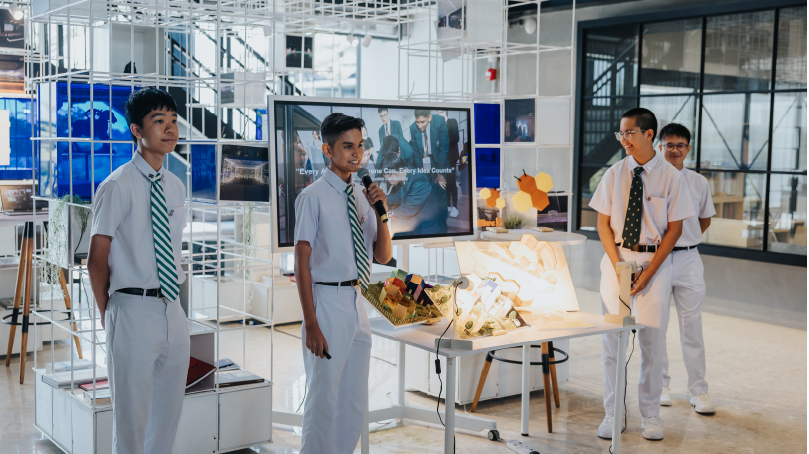
Alongside three of his teammates, Elliot presented “The Hive 5” at The Kingsmen Experience during the launch of the Design Education Advisory Committee’s Term Two Report. Photo by Penoramic Publishing.

